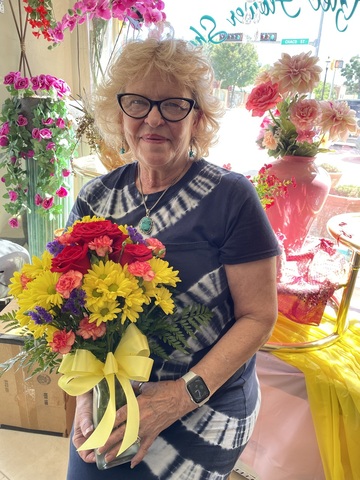
Susan Aguirre grew up on a 25-acre farm in the lower valley of El Paso, Texas, many years ago. There, she learned from her wise grandmother and other relatives how to tell what the weather will do by reading the language of nature.
It seems fitting that for the last eight years, she has been the owner of Lil Aztec Flower Shop at the corner of Chaco and Main in Aztec. There, she is surrounded by beautiful flowers, part of nature's bounty. The first year she opened the shop in 2016, people took notice. She received the Spirit Award from the city of Aztec that year. In 2017 she was named Business of the Year by the Aztec Chamber of Commerce.
The things she learned during her years growing up on the farm have never left her, and she often chats with customers about what nature reveals to us.
"Have you heard the crickets lately?" she asked me one day when I visited her store.
I stopped to think. I'd heard them two weeks before that, but I hadn't heard them lately.
"That's because they've gone underground," she told me. "They're hibernating. Ants do the same thing." It isn't until spring that they reemerge. When you stop hearing the crickets, nature is announcing that fall is coming. When June bugs come out, she added, hot weather is coming.
If you get stung by ants, bees, or other insects, she has a remedy for that. Make a paste of baking soda and water thick enough that the paste will stick to your skin. "Rub the paste all over you," she said. "It will neutralize the poison."
She added a caution. If a brown recluse spider bites you, don't wait to do the baking soda treatment. Go directly to the emergency room. Time is of the essence to find treatment before the spider's poison overwhelms your system.
Pay attention to the smells of nature, she added. "Fall smells like dying. Snow smells clean,
crisp, cold." The smells of nature will tell you what's about to happen.
She had a lot to say about the moon, which is a pretty good weather forecaster. "You can learn a lot from the moon," she said. "The moon will never lie to you."
She enumerated some things the moon tells us. A rainbow around the moon is especially revealing. "If the rainbow is tight, close to the moon, it means ice crystals are coming," she said. "The tighter the rings, the colder and the more precipitation. If the rainbow is farther from the moon, it means wind. The moon will look blurred when the wind is coming. If there are particles in the ring around the moon, the closer together the particles are, the more snow will fall. When the moon is shaped like a bowl so it could hold water, it means it will rain."
She learned early in life that if you want to know what kind of weather to expect, pay attention to
the moon and the bugs. They're as good as any weather forecaster, maybe even better.





